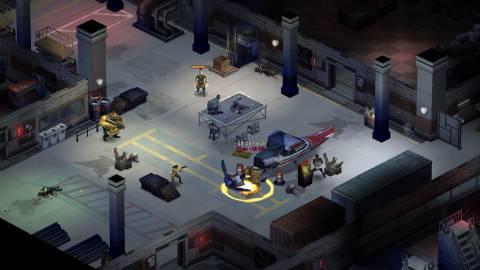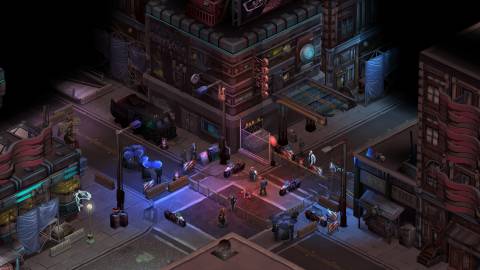Shadowrun Returns would not exist without Kickstarter, but the moment a game leaves the Kickstarter station, its crowdfunded background no longer matters. When it appeared on a marketplace with a price tag attached, it became a game that exists alongside every other game. That’s not a problem for Shadowrun Returns, fortunately, which functions just fine as a great strategy game, regardless of origin.

The Shadowrun universe, a mashup of cyberpunk and fantasy, comes from the mind of Jordan Weisman, the designer also responsible for MechWarrior and Crimson Skies. Set in a 21st century Seattle taken a turn towards the dirty, Shadowrun exists in a world where magic exists alongside your usual technology, and orcs, elves, dwarves, and dragons are real. I don’t know why this is, and Shadowrun Returns never really explains it, either, which is indicative of problems within Shadowrun Returns that run far deeper than the premise. (Wikipedia tells me the world suddenly shifted in 2011, with magic becoming part of the world, and parts of the human population randomly becoming orcs and trolls. Children became a mix of human, elves, dwarves, and other things. Who cares? It’s cool.)
Whatever one makes of the universe’s mixtape elements, it sets the strategy game up for a wide diversity of play that makes the goofiness worthwhile. The Shadowrun games produced for SNES and Genesis took RPG elements from Shadowrun’s tabletop origins and combined it with fast-paced, real-time action gameplay. Shadowrun Returns adopts a much slower pace that will feel immediately familiar to anyone who’s played XCOM: Enemy Unknown or Fire Emblem: Awakening in the past year. Viewed from an isometric perspective, players control teams of one-to-four characters, with one being your primary character and the others often hired goons. Players choose from a set of races--human, elf, dwarf, orc, troll--and assign one of several classes--street samurai, mage, decker, shaman, rigger, physical adept--that automates early stats. You can opt to not choose a class, but entry level players may feel overwhelmed by the sheer choices in stat selection.
Races define certain characteristics, and classes refine that even further. Unfortunately, pick carefully and do some research ahead of time, as Shadowrun Returns does precious little to prepare players for the consequences of their decisions. I went with an elf mage specializing in rifles, given that my spells would already be slung from a long distance. Why? Because it was easy to understand what it meant to play that class. Little did I know there’s a difference between traditional magic and conjuring, another form of magic meant for shamans. Woops, that's a wasted a set of karma (upgrade) points! Did you know deckers (hackers) can access terminals throughout the world, playing in a separate reality that can manipulate turrets and security cameras? Until the game forced a decker upon me during a mission much later in the game, I sure didn’t.
About halfway through the game, I finally came to grasp the breadth of what Shadowrun Returns had to offer, and found myself profoundly disappointed at some of my decisions, choices made in ignorance. Shadowrun Returns primes players to play the way they actually want to during a second playthrough, but only because it spends so little time explaining its nuances. I understand not wanting to include a two-hour tutorial to walk players through every detail, but giving players the option to learn that for themselves would have been useful.
But when the game finally clicks, it clicks, and there’s so much to play with. The battlefield is a toy box. Every class approaches combat so differently, and this makes encounters ripe for discovery (which, sadly, it actively discourages, but let’s talk about the ideal scenario). My favorite lineup was a mage, rigger, street samurai, and whatever class I hadn’t touched yet. Riggers are robotics experiments, capable of sacrificing their turns to different types of controllable drones. Some drones are mobile medics, others are gun-toting mercenaries. Their tiny stature means they’re able to sneak through vents, setting up all sorts of wrinkles in your tactics. I’d use my drones to suck up aggro from enemies, buff up my street samurai through my mage, and send that sword wieldin' maniac into the thick of battle, slicing down fools left and right. My street samurai would often be hiding in plain sight, while everyone else took cover around the world. Cover and movement works similarly to XCOM, with the mouse hovering over environment tiles and communicating movement cost and whether a spot will provide zero, half or full cover. Your view is fixed, though, and this lead to some costly mistakes when it’s not entirely clear where a movement choice will leave your character. For the most part, it works just fine.
Other than movement and cover, Shadowrun Returns is defined by randomness, a fickle mistress that will both reward and punish those arrogant enough to test her wrath. There are few experiences more painful than watching a carefully calculated set of maneuvers to flank a set of enemies unravel, as the text bubble “missed” show up over and over and over. While it's easy to focus on the times fate works against you, it grants unbridled power just as often. The dice rolls happening behind-the-scenes in Shadowrun Returns feel fair, pulling off the troublesome balancing act of making the player feel equally parts frustrated and elated each turn.
What’s less random is Shadowrun Returns’ much-maligned save system, which compounds the game backing players into a creative corner. There is no way to manually save, which usually means missions must be finished before you can safely turn the game off. The autosave system kicks in during loading screens, which means some multi-level missions get you off the hook. It makes sense for Shadowrun Returns to ditch players’ ability to save and load freely, as it could eliminate any sense of consequence during combat. It’s sound logic, as I’m the kind of person who freely exploited loading to avoid permanence in XCOM. This leads to some unintended consequences during unexpected difficulty spikes, bad rolls that turns an ordinary combat sequence into a shit show, or life forcing you off the computer.
Here’s a good example. Money (nuyen) is tight in Shadowrun Returns, and every purchase is important. Hiring a squad is expensive, and for just about every mission requiring one, someone gives you money upfront to make it possible. One of the game’s previous few side missions skips that step, leading me to believe I could get along with only me and another shadowrunner. That was mostly true, but the final encounter, which kicks off after 30 minutes of otherwise ordinary firefights, is much, much harder. I was pummeled after a few dice rolls went in the enemy’s favor, and it was back to the start of the level. With some creative thinking (read: running away and regrouping), I was able to complete the mission, but having to crawl through 30 minutes of battles several times over was enough to make me consider giving up on the game entirely. A save system with strict restrictions in place would have encouraged players to take risks with the gameplay systems. As it stands, saving is an wholly unnecessary hurdle to immersion.

Once you learn to begrudgingly live with the save system and get up to speed with the various classes, you begin to sigh, realizing the campaign is beginning to near its climax. When it all comes together in Shadowrun Returns, it's satisfying to watch the narrative sync up right alongside your understanding of how the game works.
There are, if you click around enough, a few ways to extend the journey. Some side missions exist in Shadowrun Returns, but the game is a largely linear affair. Finishing the campaign will probably take you between 10-13 hours, but a powerful mission editor holds tantalizing promise.
An unexpected delight was how the game encourages players to further define their characters through branching dialogue trees without the patronizing good vs. bad split in other games. My shadowrunner, Scully, would regularly scuttle between a good person caught a bad situation to an opportunistic scumbag The lack of systemic reaction opened up avenues for roleplaying without worrying about if points were going up or down.
I hadn’t touched a strategy game with any serious intent until Firaxis turned my world upside down with XCOM. Though Shadowrun Returns assumes too much about the player’s prior knowledge about the universe and too often skimps over introducing key gameplay systems, getting over the hump is worth discovering the deeply gratifying strategy game within.